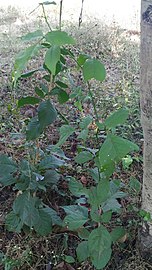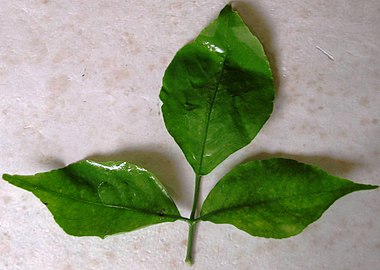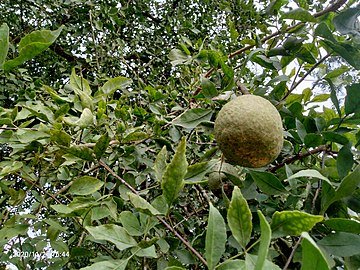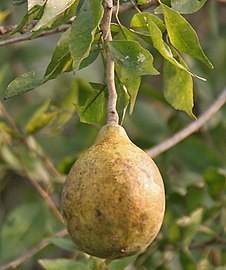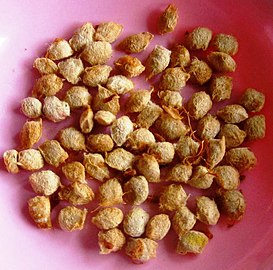Aegle marmelos
This article needs additional citations for verification. (January 2016) |
| Bael | |
|---|---|

| |
| Scientific classification | |
| Kingdom: | Plantae |
| Clade: | Tracheophytes |
| Clade: | Angiosperms |
| Clade: | Eudicots |
| Clade: | Rosids |
| Order: | Sapindales |
| Family: | Rutaceae |
| Subfamily: | Aurantioideae |
| Genus: | Aegle Corrêa[3] |
| Species: | A. marmelos
|
| Binomial name | |
| Aegle marmelos | |
| Synonyms[2] | |
| |
Aegle marmelos, commonly known as bael (or bili[4] or bhel[5]), also Bengal quince,[2] golden apple,[2] Japanese bitter orange,[6] stone apple[7][8] or wood apple,[6] is a species of tree native to the Indian subcontinent and Southeast Asia.[2] It is present in India, Pakistan, Bangladesh,[9] Sri Lanka, and Nepal as a naturalized species.[2][9] The tree is considered to be sacred by Hindus and Buddhists.
Description
Aegle marmelos is a deciduous shrub or small to medium-sized tree, up to 13 metres (43 feet) tall with slender drooping branches and rather open, irregular crown.[10]
Bark
The bark is pale brown or grayish, smooth or finely fissured and flaking, armed with long straight spines, 1.2–2.5 centimetres (1⁄2–1 inch) singly or in pairs, often with slimy sap oozing out from cut parts. The gum is also described as a clear, gummy sap, resembling gum arabic, which exudes from wounded branches and hangs down in long strands, becoming gradually solid. It is sweet at first taste and then irritating to the throat.[8]
Leaves
The leaf is trifoliate, alternate, each leaflet 5–14 cm (2–5+1⁄2 in) x 2–6 cm (3⁄4–2+1⁄4 in), ovate with tapering or pointed tip and rounded base, untoothed or with shallow rounded teeth. Young leaves are pale green or pinkish, finely hairy while mature leaves are dark green and completely smooth. Each leaf has 4–12 pairs of side veins which are joined at the margin.
Flowers
The flowers are 1.5 to 2 cm, pale green or yellowish, sweetly scented, bisexual, in short drooping unbranched clusters at the end of twigs and leaf axils. They usually appear with young leaves. The calyx is flat with 4(5) small teeth. The four or five petals of 6–8 millimetres (1⁄4–3⁄8 in) overlap in the bud. Many stamens have short filaments and pale brown, short style anthers. The ovary is bright green with an inconspicuous disc.
Fruits
The fruit typically has a diameter of between 5 and 10 cm (2 and 4 in).[11] It is globose or slightly pear-shaped with a thick, hard rind and does not split upon ripening. The woody shell is smooth and green, gray until it is fully ripe when it turns yellow. Inside are 8 to 15 or 20 sections filled with aromatic orange pulp, each section with 6 (8) to 10 (15) flattened-oblong seeds each about 1 cm long, bearing woolly hairs and each enclosed in a sac of adhesive, transparent mucilage that solidifies on drying. The exact number of seeds varies in different publications. The fruit takes about 11 months to ripen on the tree, reaching maturity in December.[11] It can reach the size of a large grapefruit or pomelo, and some are even larger. The shell is so hard it must be cracked with a hammer or machete. The fibrous yellow pulp is very aromatic. It has been described as tasting of marmalade and smelling of roses. Boning (2006) indicates that the flavor is "sweet, aromatic and pleasant, although tangy and slightly astringent in some varieties. It resembles a marmalade made, in part, with citrus and, in part, with tamarind."[12] Numerous hairy seeds are encapsulated in a slimy mucilage.
Chemistry
The bael tree contains
Aeglemarmelosine, molecular formula C16H15NO2 [α]27D+7.89° (c 0.20, CHCl3), has been isolated as an orange viscous oil.[16]
Taxonomy
Bael is the only member of the monotypic genus Aegle.[9]
Habit and habitat

Aegle marmelos is native across the
Ecology
The tree is a larval food plant for the following two Indian Swallowtail butterflies: the lime butterfly (Papilio demoleus) and the common Mormon (Papilio polytes).
Toxicity
Aegeline is a known constituent of the bael leaf and consumed as a
Doctors at the Liver Center at The Queen's Medical Center investigating the first cases in Hawaii reported that between May and September 2013, eight previously healthy individuals presented themselves at their center suffering from a drug-induced liver injury.[14][18] All of these patients had been using the reformulated OxyElite Pro, which they had purchased from different sources, and which had different lot numbers and expiration dates, at doses within the manufacturer's recommendation.[14][18] Three of these patients developed fulminant liver failure, two underwent urgent liver transplantation, and one died.[14][18] The number of such cases ultimately rose to 44 in Hawaii.[14][18] In January 2014, leaders from the Queen's Liver Center informed state lawmakers that they were almost certain that aegeline was the agent responsible for these cases,[19] but the mechanism of how aegeline may damage the liver has not been isolated.[14]
Uses
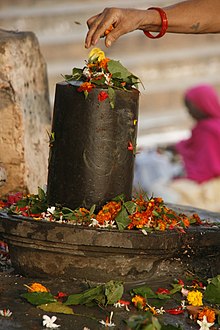
Culinary
Rich in
Traditional medicine
The leaves, bark, roots, fruits, and seeds are used in traditional medicine to treat various illnesses,[9] although there is no clinical evidence that these methods are safe or effective.[citation needed]
In culture
Bael is considered one of the sacred trees of Hindus
In the traditional practice of the Hindu and Buddhist religions by people of the
See also
References
- . Downloaded on 07 March 2021.
- ^ a b c d e f g "Taxon: Aegle marmelos (L.) Corrêa". GRIN Global, National Plant Germplasm System, US Department of Agriculture. 19 September 2017. Retrieved 16 March 2018.
- ^ "genus Aegle". Germplasm Resources Information Network (GRIN) online database. Retrieved 20 June 2017.
- ^ "FOI search results". flowersofindia.net. Archived from the original on 12 August 2017. Retrieved 20 January 2016.
- ISBN 9781465583093
- ^ a b "M.M.P.N.D. - Sorting Aegle names". unimelb.edu.au. Retrieved 20 January 2016.
- ^ "Bael: Aegle marmelos (L.) Correa". Philippine Medicinal Plants.
- ^ a b c Orwa, C (2009). "Aegle marmelos" (PDF). Agroforestree Database:a tree reference and selection guide version 4.0. Archived (PDF) from the original on 9 May 2016.
- ^ a b c d e f g Misra KK (1999). "Bael". NewCROP, the New Crop Resource Online Program, Department of Horticulture and Landscape Architecture, Center for New Crops & Plant Products, Purdue University, W. Lafayette, IN. Retrieved 20 January 2016.
- ISBN 978-974-8367-29-3.
- ^ )
- ^ Boning, Charles (2006). Florida's Best Fruiting Plants: Native and Exotic Trees, Shrubs, and Vines. Sarasota, Florida: Pineapple Press, Inc. p. 35.
- ISBN 978-979-3496-92-4. Archived(PDF) from the original on 12 June 2017.
- ^ PMID 27367536.
- ^ S2CID 205000525.
- ^ Laphookhieo, Surat (2011). "Chemical constituents from Aegle marmelos". J. Braz. Chem. Soc. [online]. 22: 176–178.
- ^ a b c "FDA Investigation Summary: Acute Hepatitis Illnesses Linked to Certain OxyElite Pro Products". US Food and Drug Administration. 30 July 2014. Archived from the original on 14 November 2017. Retrieved 19 November 2015.
- ^ S2CID 28252720.
- ^ Daysong, Rick (January 28, 2014). "Months after recall, new OxyElite Pro illnesses reported". Hawaii News Now. Retrieved 19 November 2015.
- PMID 33163665.
- ISBN 9788178330969.
- ^ a b Monier-Williams, Monier (1981). "बिल bil". A Sanskrit-English Dictionary. Delhi, Varanasi, Patna: Motilal Banarsidass. p. 684.
- ISBN 9781930722248.
- ISBN 9788122200331.
- ^ The Astrological Magazine, Volume 92. Raman Publications. 2003. p. 48.
- ISBN 9780834824232.
- ISBN 9789401001250.
- ISBN 9789400740532.
- ISBN 978-3447057523.
![]() Media related to Aegle marmelos at Wikimedia Commons
Media related to Aegle marmelos at Wikimedia Commons



